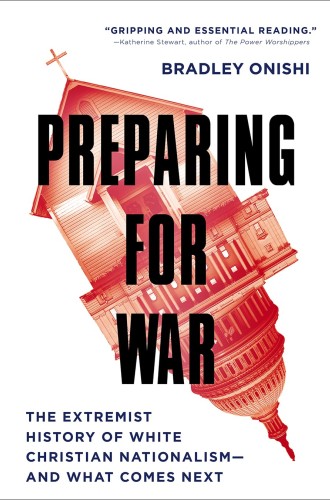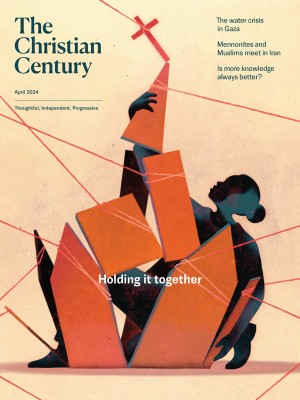White Christian nationalism’s heritage of extremism
Bradley Onishi brings his scholarship and his personal experience together to analyze where the church went wrong.
Like many Americans around the country on January 6, 2021, Bradley Onishi was horrified by the news of the insurrection at the Capitol building. But of particular interest to Onishi were the Christian flags and signs spread throughout the mob, which brought into plain view an expression of White Christian nationalism that was deeply familiar to him. As a former zealot of White Christian nationalism, Onishi was left wondering, “Would I have been there if I had not left the movement?”
The result of Onishi’s self-questioning is this book. In an engrossing 220 pages, Onishi delivers a history of the formation of the White Christian nationalism that led up to January 6, told through his own history of over a decade in the movement. Now a scholar of religion who no longer identifies as a Christian, Onishi brings his academic pursuits and personal reflections together in a mix that is both informative and accessible. Covering the mid-20th century to the insurrection, Onishi concludes that January 6 was not an aberration but the inevitable result of a movement a half century in the making.
Read our latest issue or browse back issues.
Onishi begins by distinguishing Christianity from White Christian nationalism, framing the latter as a specific identity rooted in the myth of America as a Christian nation. In each chapter, Onishi unpacks one key step in this “marriage of cross and flag,” revealing its connections to current social and political issues.
The story Onishi tells starts with a booming Cold War defense industry in the 1950s and ’60s that drew many families from the Midwest and South to Orange County, California, creating the perfect conditions for White Christian nationalism to incubate. This burgeoning movement found its first political expression in Arizona senator Barry Goldwater, whose uncompromising 1964 presidential campaign created a template that many Republicans would follow and that Donald Trump perfected in 2016. In the 1970s, White Christian nationalists formed nationwide coalitions as organizer Paul Weyrich and marketer Richard Viguerie established the new right, while evangelical pastors such as Jerry Falwell and Tim LaHaye founded the religious right. Onishi views these coalitions’ preference in the 1980 election for Ronald Reagan over Jimmy Carter—the incumbent whose Christianity was sincere but not nationalist—as evidence that “power trumps piety.” While the history of coalition organizing and election campaigns can be dry material, the way Onishi looks at it from the prism of religion and politics imbues it with interest and underscores its importance today.
Onishi prefaces his historical analysis in each chapter with an anecdote from his days as an ardent evangelical who absorbed the White Christian nationalism around him. These personal reflections ground each chapter in imagery that will be familiar to many Christian readers and provide a bridge into the book’s more challenging material. Onishi does not shy away from critiquing the problematic, often disquieting elements of White Christian nationalism. In particular, he maintains that White Christian nationalism was not only born out of White supremacy, patriarchy, and heteronormativity but that it still exists to protect these systems. He contends that the formation of White Christian nationalism in the mid-20th century was no coincidence, arguing that the movement congealed in response to the racial integration of public schools and the civil rights, feminist, and LGBTQ movements. Under the guise of protecting family values, White Christian nationalism was able to bypass the racism and sexism driving its core.
While some Christian readers may find these revelations hard to swallow, herein lies the power of Onishi’s historical research. Identifying the specific names and locations that created this movement cuts through any sense that White Christian nationalism is divinely sanctioned. Indeed, Onishi emphasizes that White Christian nationalism is a human creation, and one shaped more by political and cultural agents than by the religious sphere. “Religious communities never develop in a vacuum,” he writes, explaining that White Christian nationalism is “a conservative political-cultural-religious movement designed to keep White Christian landowners at the top of America’s political and economic hierarchies.”
In the book’s final section, Onishi returns to January 6 and uses his historical analysis to forecast what comes next. Highlighting how White Christian nationalist circles reframed the insurrection as a righteous rebellion, Onishi issues a stark warning that the incident does not mark the end of extremism in America. Rather, pointing to the ongoing migration of White Christians from diverse cities to homogeneously conservative areas, Onishi sees the insurrection as the beginning of a movement that prefers an autocratic theocracy to the give-and-take of democracy. It is this threat to American democracy, not the corruption of Christianity, that appears to frighten Onishi the most.
While he outlines the contradictions between Christianity and White Christian nationalism, Onishi does not suggest what a Christianity that is not grounded in power, White supremacy, and patriarchy might look like. In this regard, readers who are disenchanted with White Christian nationalism and are looking for a new way forward with Christianity may be left wanting. Mending Christianity is ultimately not Onishi’s project.
While providing a solid exploration of religion, this book is primarily a sociological and political analysis. Although Onishi does not hide his own political leanings, his commentary remains fair and instructive. Aside from his exhortations to choose democracy over extremism, however, Onishi does not offer a fuller vision for how to transcend the tribalism of the current political moment.
Still, there are plenty of important insights that make this book well worth it for readers across the political spectrum. The events of the past few years have brought White Christian nationalism squarely into public view, and Onishi makes a compelling case that it would be a mistake to ignore it. The history of White Christian nationalism is not just the history of the church but the history of America. This book will provide a helpful entry point to anyone wanting to understand this expression of Christianity and reckon with its impact in American society today.







